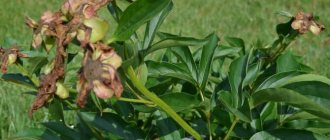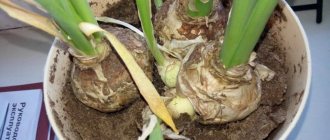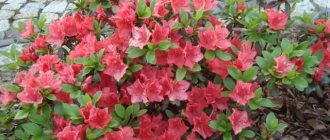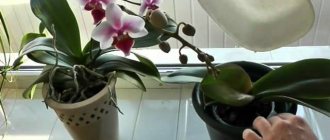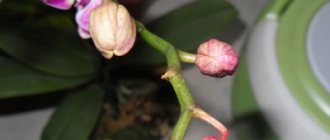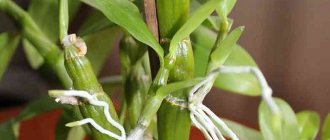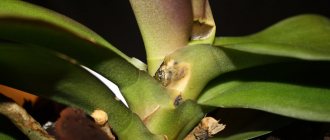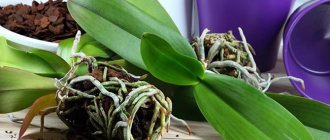Flowering period for orchids
Flowering time is specific to each variety. Creating favorable conditions will allow the orchid to grow and bloom for a longer time. What to do with an orchid after flowering at home?
Orchid blossom
Experienced flower growers know that re-blooming can only occur if a number of conditions are met. First (and most important) – the leg must be healthy. The age of the plant is also important. Early flowering can destroy too young plants, which puts the flower at risk of not recovering. It is easy to distinguish between an adult and a young plant: an adult orchid must have at least 5 branches, 7-8 is considered a standard indicator for it.
Important information! It takes less time to process orchids growing strictly vertically than orchids growing to form bushes.
Another factor that guarantees repeated flowering is the presence of regular lighting. By reducing watering and lowering the temperature for several days, it is possible to stimulate the appearance of new flowers. When the buds grow, proper watering is necessary. Spraying is recommended during the heating season. Excessive use of nitrogen supplements negatively affects plant development.
Is it possible to influence the flowering of phalaenopsis?
The specifics of development also determine the main feature of growing phalaenopsis: they actually do not require significant changes in living conditions, much less certain regimes, so characteristic of their relatives.
Paradoxically, the absence of any visible guidelines and strict recommendations makes growing phalaenopsis more difficult: dozens of questions and uncertainties arise. Do I need to do anything to get the orchid to bloom again? How to predict flowering times? What to do if the buds do not bloom for too long?
And the answer to these and dozens of other questions is always the same: you need to rely on the orchid itself and do nothing. Phalaenopsis will bloom when they are ready, in the right conditions and with good care. Providing them with the care they need is the whole task. And if you solve it correctly, you won’t have to wait long for adult plants to bloom.
The timing of flowering of phalaenopsis depends on a dozen factors both in the period between flowering and during the previous flowering:
- the condition of the orchid itself (age, timing “habits”, quality of roots, number of leaves, absence of problems with diseases and pests, etc.);
- amount of light and duration of daylight hours;
- temperature;
- quality of care (watering, fertilizing, their compliance with the needs of the plant);
- cleanliness of leaves;
- stability of conditions and the presence of additional stress factors.
The interdependence of all parameters affecting the timing of flowering is not always traceable and is not so obvious. From the slightest changes in the humidity of the substrate, air, temperature fluctuations, daylight hours, frequency of watering and fertilizing, this orchid can either bloom faster or make it wait months longer.
The timing of flowering of phalaenopsis depends on a dozen factors both in the period between flowering and during the previous flowering. © Jes Lu
What to do with the peduncle
The orchid has faded, what to do with the arrow: options for care and pruning
You should not cut off the arrow on which the flowers were located. Over time, new shoots may form on the peduncle, and a young flower bud may appear from the shortened stem. If necessary, the peduncle is shortened to a height of 1 cm above the last dormant embryo. This leads to the formation of new lateral arrows. Flowering on a side branch is usually not as pronounced as compared to a branch that has just faded.
Stem pruning
There are three ways to treat flower stems:
- Trimming. Green phalaenopsis inflorescences form new flowers. Patience is important at this stage as they can take 1-3 months to form after the previous flower has dropped. Some gardeners prefer to cut the stems of the peduncle. A series of annoying arrow trimmings are carried out in the spring. To do this, the plant is cut 2-2.5 cm above the dormant bud. For phalaenopsis, the optimal breeding season is summer.
- It is recommended to remove dry dark arrows. This should be done only after the flowers have completely dried. From the wilted stems of the inflorescence, the nutrients accumulated during flowering enter the plant. They are necessary for further recovery and growth. Dried flower buds are cut off at a height of about 2 cm from the base. After a few months, under optimal conditions, the orchids will form new inflorescences. Dormant buds are capable of forming new shoots.
- Premature pruning of orchids delays the recovery period and flowering of phalaenopsis by at least six months. If drying does not spread further along the flower, it is worth cutting off the arrow with flowers onto living tissue. Dormant buds may later bloom. Trimming flower shoots above the buds at a height of 1.5-2 cm will allow you to effectively propagate phalaenopsis.
Additional Information! There is no urgent need to trim the green stalks immediately after flowering.
When should an orchid bloom?
Depending on the variety, orchids bloom for the first time at the age of 1.5-3 years. Flowering lasts from several weeks to 6 months, and in phalaenopsis it can occur several times a year. After this, the weakened plant needs to be provided with a period of rest, during which it regains its strength.
Signs that the orchid has faded are:
- fallen flower petals;
- absence of unopened buds;
- there are no green swollen buds on the peduncle;
- the green peduncle acquires pink-violet, brown or waxy shades.
Reference! If all the signs are observed, it means that the phalaenopsis has finished flowering and is entering a dormant stage.
Orchid arrow: to trim or not
Rhododendron has faded: what to do next
After the orchid blooms, you can cut off the peduncle. The condition is mandatory for Cumbria, Cymbidium and Oncidium orchid varieties. A larger number of kidneys does not guarantee a positive result. The orchid has faded, what should I do with the arrow? In Miltonia, it is recommended to clean the pedicels “in advance” during the period when they begin to directly wither. There is no need to wait until the flowers fall completely.
Difference between partial and complete removal
Pruning of a house plant is required only when the arrow is dry. If there are still live inflorescences on it that have not bloomed, it is better not to touch them and wait for new flowers to appear. It is important to remember that the plant accumulates nutrients in pseudobulbs. In general, plants with faded stems look unsightly.
Removing the peduncle is easy. After the orchid has faded, it is trimmed with a knife, scissors or pruning shears. Tools must be disinfected first. It is recommended to leave the buds about 1 cm and treat the slices with chopped charcoal or other means. The orchid has faded, what should I do next? Some experts suggest “sealing” areas with natural beeswax.
It is important to know! Most orchids have hollow stems. When watering after removing the pedicels, it is important to be careful, because if water gets inside the stem, this can lead to rotting and fading of wilted orchids.
If there are buds on the cut arrows, they can be used as planting material that is propagated by cuttings.
Partial cutting
Partial reduction of the arrow is one of the possible solutions. The method is best suited for phalaenopsis. Studying the stems will reveal the presence of “dormant buds” in plants, from which “babies” and lateral inflorescences appear. In this case, experienced flower growers cut the stem after it has become dry, but not completely, but at some distance from the buds. The result of flowering is new leaves and aerial roots.
Partial circumcision
Interesting! A dry and cool microclimate will increase the likelihood of bolt formation, while a moist and warm microclimate will promote reproduction.
If a wilted phalaenopsis orchid dries out, its stem will begin to turn yellow. In this case, it is removed to the lowest shoots.
Plant with a central arrow
a central arrow in an orchid , that is, an arrow growing from the growth point, means that the phalaenopsis has stopped growing in height and will no longer be able to grow leaves.
This does not mean that pruning after flowering will destroy the orchid .
Attention! If there is a central arrow at the base of the rosette, children form from the axillary buds, which means there will be many flower stalks, and the plant will delight with its amazing beauty for a long time.
The acquisition of such an extraordinary orchid can be considered lucky.
What are the advantages?
Now, in place of the rosette of such an orchid, children will form . They can appear from dormant buds, which are located in the axils of the lower leaves or on the peduncle itself.
All you have to do is wait until the children grow up a little and are ready for replanting, which will allow you to get not one, but several plants at once.
What to do with the stem
Hyacinths have faded: what to do with them next
To figure out what to do with an orchid after flowering at home, it is important to understand what to do with the stem. There is a step-by-step algorithm of actions:
- Trim the sheet along the center line to the very bottom.
- Carefully remove the two halves from the stem with your hands.
- Do not water the orchid for several days. The wound should be dry to prevent destruction of the flower.
Dry and yellowed leaves are removed in the same way. If they are green but dry, you should wait, perhaps their elasticity will return. If they do start to turn yellow, it is important to wait until they are completely dry before cutting them off. Beneath the removed leaves you can find everything from young aerial roots to new shoots that have begun to form. What transplantation algorithm is decided by the florist in relation to local conditions.
Follow these 9 rules and your orchid will bloom all year round
Looking at a blooming orchid, many gardeners don’t even think about whether to buy this extraordinary plant or not. Of course, buy! But will it bloom just as well at home?
Everyone knows that an orchid is a rather capricious plant and requires meticulous care. You can achieve repeated flowering from it if you know all the factors that contribute to this and follow a certain care regimen. Then the orchid will bloom for 2 to 6 months. And some genera, like phalaenopsis or vanda, can bloom all year round.
For an orchid to bloom...
The frequency of orchid flowering depends on compliance with certain care rules. In order for a plant to bloom, you should remember 9 important conditions that contribute to this.
1. Find out the age of the orchid
If you bought a non-flowering plant, and it is in no hurry to please with flower shoots, perhaps it is still too young. Different types of orchids bloom at the age of 1.5 to 3 years. To determine that an orchid is old enough, you need to count the number of shoots. An adult plant ready to flower should have from 5 to 8. If flowers appear on an orchid earlier, this is not always good. The fact is that a plant that is too young may not have enough strength to recover after flowering, and the orchid may die.
2. Don't move the potty
Many people know that moving is a real stress for an orchid. But this flower does not like even minor movements. The orchid reacts to its position in relation to the light. Therefore, if there is a need to rearrange a pot with a plant, it is necessary to place it with the same side to the light source as it was before. Also, do not move the orchid while watering. Movement adversely affects the growth of the flower, especially at the moment the peduncle appears.
3. Pay attention to the roots
As you know, orchid roots are actively involved in the process of photosynthesis, so it is important to ensure that they have enough light. Since it is not recommended to move the orchid again, it is worth taking care of the roots in advance. For example, instead of ceramic pots, it is better to use transparent plastic containers with plenty of drainage holes. It is not recommended to use containers with corrugated walls for planting this flower, since its roots tend to grow to uneven surfaces. In addition, sharp edges and elements can injure the root system, which will harm the entire plant as a whole.
4. Take care of lighting
Sunlight is a very important factor affecting the flowering of an orchid. Without full daylight (10-12 hours a day), these plants will not bloom. Therefore, in autumn and winter, when there is very little natural light, flowers should be illuminated with lamps.
Phytolamps are special lamps designed to illuminate plants: they provide a lot of bright light without drying out the air around the flowers.
If an orchid produces a peduncle in autumn or winter, care should be taken to ensure that it does not die due to the short daylight hours. Without additional lighting in the dark season, the peduncle may stop developing or dry out. If it is not possible to illuminate the entire plant, it is enough to provide illumination only for the tip of the peduncle. The main thing is to make sure that neither it nor the plant itself gets hot.
5. Ensure acceptable temperature differences
The catalyst for flowering of many types of orchids is a slight difference between day and night temperatures. Therefore, for an orchid to bloom, the temperature at night must be 4-6°C lower than during the day. Of course, creating such conditions throughout the year can be problematic. But from late spring to early autumn, orchids can be kept outdoors, where the temperature difference is achieved naturally. In cooler times, when flowers should already live at home, rooms with orchids need to be ventilated. Just do this very carefully, remembering that these plants are very afraid of drafts.
6. Water your orchid correctly
You need to water the orchid after the soil dries out - this will make it possible to avoid rotting of the roots. These requirements apply both in summer and winter and apply to both children and adult plants. However, there are some exceptions here. After the orchid has faded, watering should be reduced by about a month.
In nature, after flowering, orchids begin to set seeds, which should scatter in different directions for several kilometers. This is only possible during dry periods, but not during the rainy season. Therefore, it is necessary to provide the orchid with conditions that are as close to natural as possible - then the flower will grow healthy and bloom often.
Before and during flowering, the orchid requires more intensive watering than usual. Further, during the dormant period, specimens with hard leaves and the presence of pseudobulbs should be watered according to the basic principle (after about 10-12 days).
7. Humidify the air around the plant
Another important condition for flowering is air humidity. If there is not enough of it, the orchid may stop growing or unopened buds and flowers may dry out prematurely.
To increase the humidity in the room where the orchid grows, you can place a plate of water next to the flower. Also, during very dry periods (when the heating is turned on in houses), the plant should be sprayed. Suitable humidity for orchids is 60% and above.
8. Choose the right fertilizers
To feed orchids, it is recommended to use formulations based on phosphorus and potassium, as they stimulate the appearance of flower buds. In addition, the use of such fertilizers ensures that the plant produces healthy and strong flowers. But it’s better not to get carried away with nitrogen-based fertilizing: this element, on the contrary, inhibits the development of flower stalks.
9. Don’t be afraid to “scare” the plant
Sometimes, to make an orchid bloom, it needs to be given a little stress. It happens that all the conditions for flowering are met, but the flower stubbornly refuses to shoot. This sometimes happens because the orchid is doing too well. In this case, the plant directs all its energy to the growth of green mass. One way to stimulate flowering is to “shock” the orchid a little: reduce watering or move the plant pot to a cooler place.
Dormant period in orchids
After flowering, the orchid enters a period of rest, when it begins to accumulate strength for a new flowering. Care at this time is no different from care during other periods. The flower still needs good watering , high humidity , sufficient lighting and regular prevention against diseases and pests .
As for fertilizing , their frequency and volume during the rest period should be reduced. If there is a need to replant an orchid, then the time to do this procedure is now, when the plant no longer blooms.
Replanting is necessary if roots are sticking out of the drainage hole, or the soil dries out quickly after watering. As a rule, the need for this procedure appears after 2-3 years.
Are orchids suitable for cutting?
What could be more beautiful than a bouquet of orchids? But these flowers do not live long, and not every species is suitable for cutting. Let's try to figure out how to extend the life of an epiphytic bouquet and which orchids to choose.
Phalaenopsis, cymbidiums and paphiopedilums can stand in a vase and retain freshness and aroma for several weeks (and sometimes even a month) . Other orchids risk not standing for even an hour, literally withering before our eyes.
If you purchase cut orchids, look first at the petals and sepals. They should be shiny, as if covered with wax, and hard - then the orchid will last a long time.
How to extend the life of a bouquet of orchids:
- If the flowers were brought from the store, then their cuts need to be updated . The stems should be cut at an angle. It is recommended to carry out the procedure under running water. It is advisable to update sections every 2-3 days.
- The water for keeping cut orchids should be soft and clean: you can use boiled or filtered water. It needs to be updated periodically by adding fresh water.
- Cut orchids, as well as potted home orchids, are afraid of too high and very low temperatures . It is also recommended to protect them from drafts and bright sun .
Source: smilepub.com
How to properly replant an orchid after flowering?
Orchid owners try not to get carried away with replanting. This is usually done every two to three years. The fact is that the process is accompanied by stress for the plant: the loss of flowers inhibits the growth of rhizomes. The date of replanting depends on the type of orchid. Transplantation is done only in the spring.
Orchid transplant
When new shoots appear, lady's slippers, oncidiums and cattleyas are moved to a separate pot (do not wait until they begin to take root). The signal for phalaenopsis transplantation is a fresh tip near the root. If the orchid is rotten, the flower needs saving. Reasons for an emergency transplant may include:
- root rot;
- the appearance of pests;
- degraded substrates (soil);
- The rhizomes do not fit in the pot.
You should know! Hard water (high content of iron and other heavy impurities) accelerates the process of salinization and decomposition of the soil, which negatively affects how the orchid fades.
Premature drying of the peduncle
The peduncle is a temporary shoot of a flower. Its life is characterized by 1-2 periods of flowering. Premature endings of flowering are rare. If Phalaenopsis blooms quickly, this indicates poor immunity of the plant and its unpreparedness for budding.
If the orchid has bloomed prematurely, check the condition of the plant's roots. They should not be wet or moldy. Healthy roots are firm and green. The damaged root system is trimmed, removing all areas affected by rot, and also transplanted into a new substrate.
If the orchid has bloomed prematurely, check the condition of the plant's roots.
Duration of dormancy after flowering
The orchid rests during the cold season. Caring for the plant during this period has its own characteristics. The watering problem is solved by reducing the number of procedures. The base must dry. The standard rest period between waterings is no more than one and a half weeks. The water is removed. For orchids on the cold side there is a risk of low temperature at the roots, so the drainage device must be high.
Flowers should be kept dry otherwise there is a risk of bacteria and fungi. For thermal insulation, you can place a sheet of foam under the flower pot, or place the plant in a container with a high bottom. It is necessary to promptly identify diseases and pests and apply effective means of combating them. Preventative actions are also necessary.
Soft “hints” of a dry period
It seems that watering and feeding orchids is as easy as shelling pears. It is worth immersing the container in water with a portion of “orchid” fertilizers after the substrate has dried, just “saturate” it - and the job is done. But phalaenopsis needs adaptive watering; these frequent procedures during growth should alternate with more restrained ones to “launch” flower buds and during flowering. And fertilizers are not used all year round.
Too much watering is the main enemy of phalaenopsis flowering. They lead to the development of vegetative buds to the detriment of the development of peduncles, so you should not be too careless about watering after the previous flowering. For phalaenopsis to begin its next flowering cycle, the plant must sense signs of an approaching dry period - mimicking the reduction in rainfall in nature.
For phalaenopsis, it is enough to reduce watering to transition from the period of active green growth to the beginning of the development of peduncles. Reduce watering in the last quarter or third of active growth, focusing on the size of the leaf. It is enough to wait 2-3 weeks between waterings, “hinting” the orchid to the need to release a peduncle and stop feeding before the flower shoot begins to grow.
Care is again given abundantly - with the usual watering and fertilizing - as soon as the young shoots begin to grow and until they reach a height of about 30-35 cm. Repeatedly increasing the pause between waterings will stimulate flowering. But feeding is stopped only when the first bud begins to bloom and is resumed only after flowering, during the new growing season.
Too much watering is the main enemy of phalaenopsis flowering
Features of care during the rest period
Most hybrid indoor varieties are not sprayed in winter. Stagnant moisture can cause decomposition. On the other hand, excessively dry air (up to 40% humidity) creates conditions for the appearance of pests. To avoid this misfortune, you should regularly turn on the humidifier. In the future, this will help you understand how to care for your orchid after flowering.
Temperatures from +15 ℃ in the evening to +23 ℃ during the day are considered comfortable. A difference of 5-6 ℃ affects the flowering rate. The temperature is regulated by opening the window at night.
Ventilation is extremely useful, but flowers should not be left in a draft (risk of hypothermia). Orchids love light. The height of the lighting equipment (usually fluorescent) is 20 cm above the flower. Higher than 30 cm is not recommended. The main thing is not to place too strong a spotlight (60 W is enough).
Additional Information! In dim light, the leaves stretch and become dull in color.
In winter, fertilizing is carried out no more than once a month or even less often. At lower ambient temperatures, flowers “digest” nutrients less well and take longer to fertilize, which ultimately can prevent them from blooming.
Caring for orchids during the dormant period and after flowering has its own particularities. Knowing the rules for growing individual varieties, even an inexperienced florist can successfully cope with this task.
Caring for phalaenopsis after it blooms
Partial or complete cutting of the peduncle is stressful for the orchid, so no manipulations are carried out with the flower for some time. Next, care procedures are resumed so that the plant is fully restored for the next flowering.
Watering
The watering regime for an orchid at rest is different from the moisture regime for a flowering plant. The substrate is watered moderately, taking pauses to dry it.
This process is different for different types of flowers:
- Phalaenopsis, miltonia, paphiopedilum are watered evenly throughout the year. Watering is reduced only when unfavorable conditions arise in late autumn and winter.
- For dendrobiums, laelias, cattleyas and oncidiums, watering is reduced immediately after flowering until a new stem sprouts.
- Rarely found calanths, playones, tunias and a few dendrobiums require drying of the substrate during the dormant period.
Transfer
The dormant period is the most suitable time to transplant an orchid into a new container. Usually the procedure is performed once every 2-3 years. Phalaenopsis is also transplanted in the following cases:
- the substrate does not hold moisture, has crumbled, is covered with a coating of salts from hard water and fertilizers;
- the root system is cramped in the old container, there are dried or rotting roots;
- Diseases or pests are found in the root system.
A pot of larger diameter is selected. The substrate can be purchased at the store or prepared independently. To do this, use a mixture of bark, peat, moss and coarse river sand.
The procedure is performed in stages:
- The flower is carefully removed from the pot. If the roots come out into the holes, cut the container.
- The roots are washed in warm water. Dried, broken, rotten areas are cut off, and the cut areas are treated with an antiseptic.
- A drainage layer (expanded clay, pieces of foam plastic) is placed at the bottom of the pot. A small layer of substrate is poured on top.
- The orchid is lowered into the pot, the roots are evenly placed around the perimeter.
- The free space is filled with the substrate, shaking the pot slightly, but without compacting it. The large bark is first laid, then the medium one, with small pieces on top.
- The substrate is placed so that the leaves and growth points are on top.
Watering begins after 2-3 days so that the orchid has time to adapt. The required humidity is maintained at this time by regularly spraying the leaves. The first fertilizing is applied a month later.
Top dressing
A plant that is exhausted after flowering needs feeding to restore its strength. In addition, in a faded orchid, leaves and root mass begin to develop intensively before the resting phase. The flower is fed for 7-10 days, then left untouched for 14-20 days.
When at rest, phalaenopsis is fed with special nitrogen-containing fertilizers for orchids with a small amount of phosphorus. This slows down the development of a new peduncle, providing the flower with time to recover. Fertilizer is applied in small doses to the moistened substrate.
Reference! A sign of proper feeding is strong green roots.
The role of the peduncle in the life of the plant
The peduncle, or arrow, is the shoot on which orchid buds are formed . Sometimes novice gardeners accidentally remove it or bury it in a pot, confusing it with a root, so it is important to know what their main differences are:
- the arrow is scaly, and the roots are smooth;
- the peduncle grows from the leaf axils on the stem, and the root from the root collar;
- the ends of the arrow are slightly pointed.
If an orchid throws out an arrow, then it is actively growing and forming buds. Suspension of peduncle growth signals that the plant requires care.


